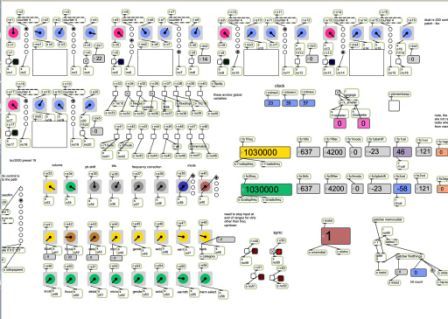radiosynth
radiosynth
Radios produce magical sounds. As a kid I spun the dials of my brother's Hammarlund HQ-120 shortwave receiver to make make blips and whooshing sounds.
After collaborating with Wade Kavanaugh on 'When Touch is Touch, I was inspired to write a program that would use radios as musical instruments.
The programs were written in Max/Msp. The first version used signal processing and mixers to alter sounds coming from several radios. Here are two examples:
Rsynth audio clip 1
Rsynth audio clip 2
The most recent versions use two Tentec rx320 black box shortwave radios. Instead of audio signal processing, the program uses a Behringer bcr2000 control surface to operate the radios. Max/Msp also provides automation. For example, frequency can be modulated by various wave shapes. The radios can be synced. There are five modulators which target any parameter of the radios and the modulators themselves. Modulators and 'presets' can also be controlled by any MIDI device. The biggest obstacle to producing interesting sound is that the rx320's operate at 1200 baud. But they have interesting quirks, for example, one of the radios will respond to negative frequency data.
With an eye toward live performance the user interface is based on LED's. This allows a large amount of data to be conveyed on a small screen. The LED's represent numerical data and routing options. Here is a conventional user interface screen for this project:

Compare this to the LED interface in the following video. This example uses only one radio. The radio is initially set to a negative frequency. Frequency is being modulated by a hyperbolic cosine function. The rate of change of that function is being modulated by a cosine function.
Here is an example of a simple beat made by combining signals from two radios which are panned left and right:
Rsynth audio clip 3